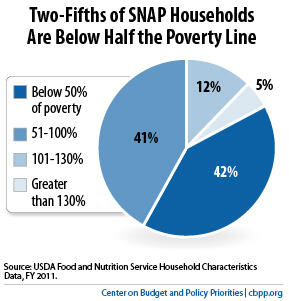off the charts
POLICY INSIGHT
BEYOND THE NUMBERS
BEYOND THE NUMBERS
With the Senate and House Agriculture Committees considering changes next week to SNAP (the Supplemental Nutrition Assistance Program, formerly food stamps), we are beginning a series of posts today that will lay out basic facts about the nation’s most important anti-hunger program. This first one starts with the people it serves.
- SNAP households have very low incomes. Over 80 percent of SNAP households have gross incomes below the poverty line ($23,500 a year for a family of four in 2013). Over 40 percent have gross incomes below half the poverty line (see graph).
Image

- Close to two-thirds of SNAP recipients are children, elderly, or disabled. Also, most SNAP families with children that include at least one working-age, non-disabled adult are working households.
- For many of the poorest Americans, SNAP is the only form of income assistance they receive. Temporary Assistance for Needy Families (TANF) cash assistance, state general assistance, and unemployment insurance are simply not available to millions of jobless households. Only about , for example.
- SNAP helps many households lift themselves out of poverty. SNAP lifted about 4.7 million Americans above the poverty line in 2011, including about 2.1 million children, according to CBPP analysis using a measure of poverty that counts SNAP as income.
SNAP is also a powerful antidote to extreme poverty. The number of U.S. families living on less than $2 per person a day — one World Bank definition of poverty for developing nations —doubled between 1996 and 2011, as did the number of extremely poor children. However, counting SNAP benefits as income cuts the number of households in extreme poverty in 2011 from 1.46 million to nearly 800,000 and cuts the number of children in extreme poverty from 2.8 million to 1.4 million.
- SNAP benefits average less than $1.50 per person per meal. That figure will drop to about $1.40 this fall, when the 2009 Recovery Act’s temporary benefit boost ends. The SNAP benefit formula assumes that families will spend 30 percent of their net income for food; SNAP provides enough benefits to meet the cost of the “Thrifty Food Plan,” the Agriculture Department’s estimate of a bare-bones, nutritionally adequate diet.
For more information, see our Chart Book.
Next up: SNAP Supports Work.
Topics:
Stay up to date
Receive the latest news and reports from the Center
